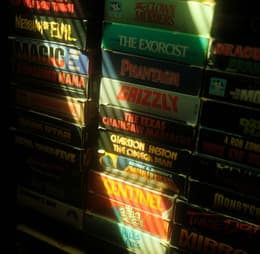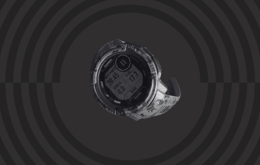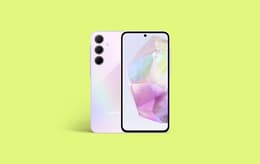
Over recent years the VHS has staged an unlikely comeback, with Hollywood studios releasing new films onto video tapes and this historic format coming back from the dead. We spoke to experts on why fuzzy video tapes remain an alluring concept in 2025.
Once upon a time, a lot of people believed VHS was dead as a format. With the arrival of DVDs and high-definition TVs, the idea of fuzzy images and waiting ages to rewind your movie was pretty archaic. The production of new VHS players being nixed altogether in July 2016 seemed to mark a concrete end. And, on top of that, the rise of streaming in the last decade felt like a final nail in the coffin for watching flicks on old video tapes.
But it looks like VHS is fighting back from the grave. The format has seen a revival similar to that of cassettes and iPods over recent years, with VHS advocates swearing that - despite its obvious technical limitations - the video tape still offers something unique, quaint and beneficial over other visual formats.
Take its imagery. The charming VHS aesthetic, which is built on grainy colours and stuttering visuals, has been re-claimed by Gen Z. Search on Tiktok, Instagram, or even watch a new music video from your favourite pop star, and this fuzzy aesthetic is impossible to avoid. Swathes of young people are purchasing tape-operated cameras, too, and even using “VHS filters” to give their selfies a retro feel.
“Nostalgia is high right now and people just want to get back to simpler times,” explains Josh Schafer, the founder of Lunchmeat VHS, a community, magazine, and retailer that sells limited editions of new and old horror movies onto video format.

Horror has played a pivotal role in the VHS revival.
“Analog is real, and it has idiosyncratic properties that make it special, especially for people born in the 80s and 90s. I think the lo-fi aesthetic of VHS is particularly attractive as it means people can unplug from modernity.”
This “unplugging” seems to be happening more and more, and the new VHS releases popping up year-on-year would have likely been impossible just a few years ago. Last year the horror blockbuster Alien Romulus saw a VHS release, marking the first VHS release of a new film from a major Hollywood studio in nearly two decades.
Meanwhile, mega pop-stars and musicians like Weyes Blood and Kesha have each doled out limited edition video tapes featuring compilations of their music videos. It seems like artists and studios are cottoning onto the niche charms of VHS, and the fact that a limited edition tape is almost guaranteed to sell out every single time.
This means more and more people are considering buying retro VHS players off Back Market, and we’re seeing a boosted demand for rare tapes as well. The latter is selling for outrageous prices within the second-hand collectibles market: in 2023 a sealed copy of The Goonies’ 1986 VHS release sold for a whopping $125,000 at auction. Just like vinyl, there are enthusiasts actively searching for what they consider to be holy grail VHS tapes.
Witter Entertainment is another company that’s been at the heart of the VHS revival, working with artists and studios like Broke Horror Fan, Bloody Disgusting, and Cineverse to release underground horror classics onto the format. Over recent years it’s had popular new VHS releases, including an officially licensed boxset of George A. Romero’s classic 1968 zombie film Night of The Living Dead. This release was sold in Walmart stores across the United States, a clear sign that major retailers are seeing the value in video once again.
“Nostalgia is high right now and people just want to get back to simpler times, which has benefitted VHS” - Josh Schafer, the founder of Lunchmeat VHS
According to its founder James Cilano, horror as a genre has been a key driver in bringing video tapes back from the dead. “Objectively, VHS is the poorer format for viewing, sure,” Cilano explains, “but subjectively? That’s another story. VHS entwines so perfectly with horror; it [enhances] something meant to be dark and gritty from the outset, and the lo-fi goriness amplifies the vibe of scary movies. Sometimes, 4K is just too clean for a horror viewing experience.”
One of the key recent horror releases on VHS has been the Terrifier movies, which centre around a homicidal clown and feature the kind of violent special effects that serve as pure nightmare fuel. Witter sold the original Terrifier in video format and saw great success.
“Terrifier is certainly the best selling modern era VHS release, with sales in the thousands,” says Cilano. “Because of its success, more artists and studios are taking notes, realizing VHS is an opportunity to extend their IP into something clearly growing in popularity.”
Lunchmeat’s Schafer, who has around 3,000 video tapes in his personal collection, shares similar thoughts around horror driving demand. “A lot of horror movies, especially the more low budget fare, just feel better on VHS,” he claims. “Not everything has to be super hi-def. Sometimes it’s okay to blur the world a little bit, because if things look too real it takes you out of the cinematic world.”
So, can this current VHS boom be sustained? According to Schafer, there’s a general fatigue around streaming, which will only continue to boost VHS as a format. “VHS holds the key to so much underground, unseen, and wild stuff,” he says. “It also preserves and offers classics of all kinds. I think people are realizing streaming is nothing more than a prescriptive menu, with an agenda from whichever platform serves it. Therefore, you need to make your own choices and roam through the cinema universe. The only way to do that with complete autonomy is with physical media formats like VHS.”
So, what are you waiting for? It’s time to go up to your loft, dust the cobwebs off that old VHS player, and enter a world you might have thought was dead in the water (it helps, too, if you get a conversion lead to connect it to a HD TV). Video, it seems, is here to stay.















